Abstract
OBJECTIVE: To recommend appropriate levels of calcium intake in light of the most recent studies. OPTIONS: Dietary calcium intake, calcium supplementation, calcium and vitamin D supplementation; ovarian hormone therapy in postmenopausal women. OUTCOMES: Fracture and loss of bone mineral density in osteoporosis; increased bone mass, prevention of fractures and improved quality of life associated with osteoporosis prevention. EVIDENCE: Relevant clinical studies and reports were examined, in particular those published since the 1988 Osteoporosis Society of Canada position paper on calcium nutrition. Only studies in humans were considered, including controlled, randomized trials and prospective studies, using bone mass and fractures as end-points. Studies in early and later phases of skeletal growth were noted. The analysis was designed to eliminate menopause as a confounding variable. VALUES: Preventing osteoporosis and maximizing quality of life were given a high value. BENEFITS, HARMS AND COSTS: Adequate calcium nutrition increases bone mineral density during skeletal growth and prevents bone loss and osteoporotic fractures in the elderly. Risks associated with high dietary calcium intake are low, and a recent study extends this conclusion to the risk of kidney stones. Lactase-deficient patients may substitute yogurt and lactase-treated milk for cow's milk. True milk allergy is probably rare; its promotion of diabetes mellitus in susceptible people is being studied. RECOMMENDATIONS: Current recommended intakes of calcium are too low. Revised intake guidelines designed to reduce bone loss and protect against osteoporotic fractures are suggested. Canadians should attempt to meet their calcium requirements principally through food sources. Pharmaceutical calcium supplements and a dietician's advice should be considered where dietary preferences or lactase deficiency restrict consumption of dairy foods. Further research is necessary before recommending the general use of calcium supplements by adolescents. Calcium supplementation cannot substitute for hormone therapy in the prevention of postmenopausal bone loss and fractures. Adequate amounts of vitamin D are necessary for optimal calcium absorption and bone health. Elderly people and those who use heavy sun screens should have a dietary intake of 400 to 800 IU of vitamin D per day.
Full text
PDF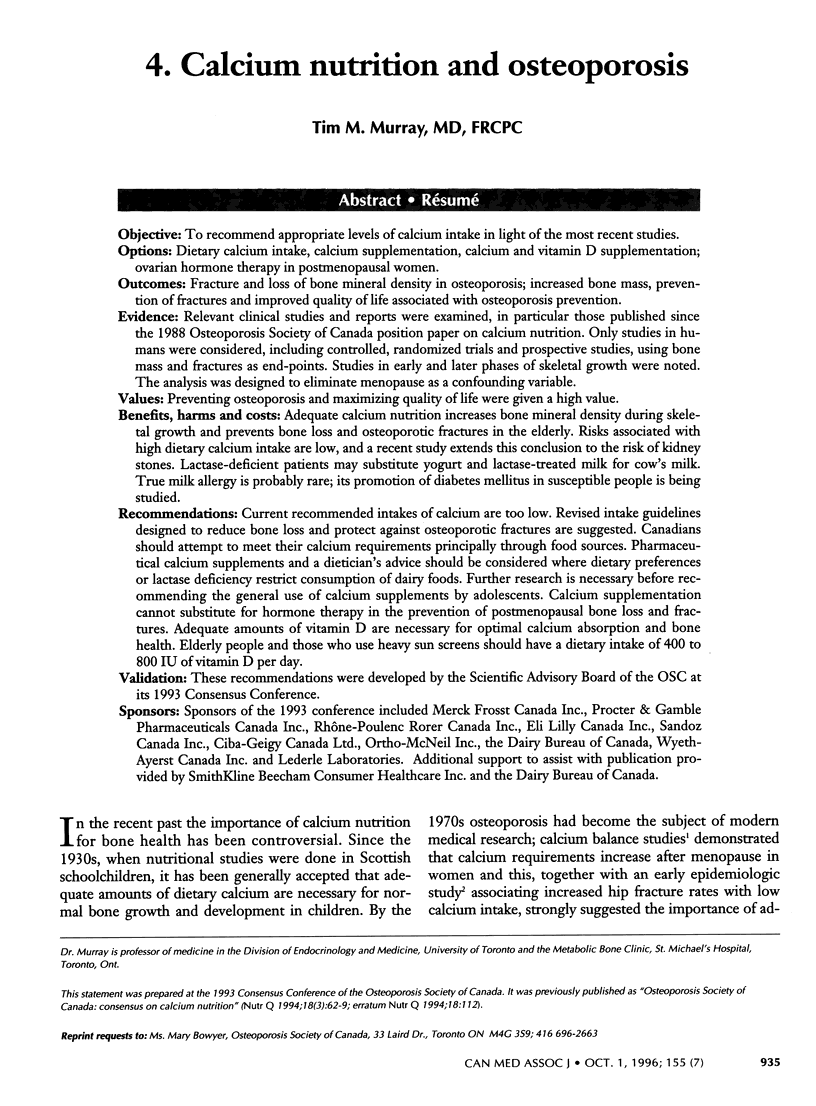
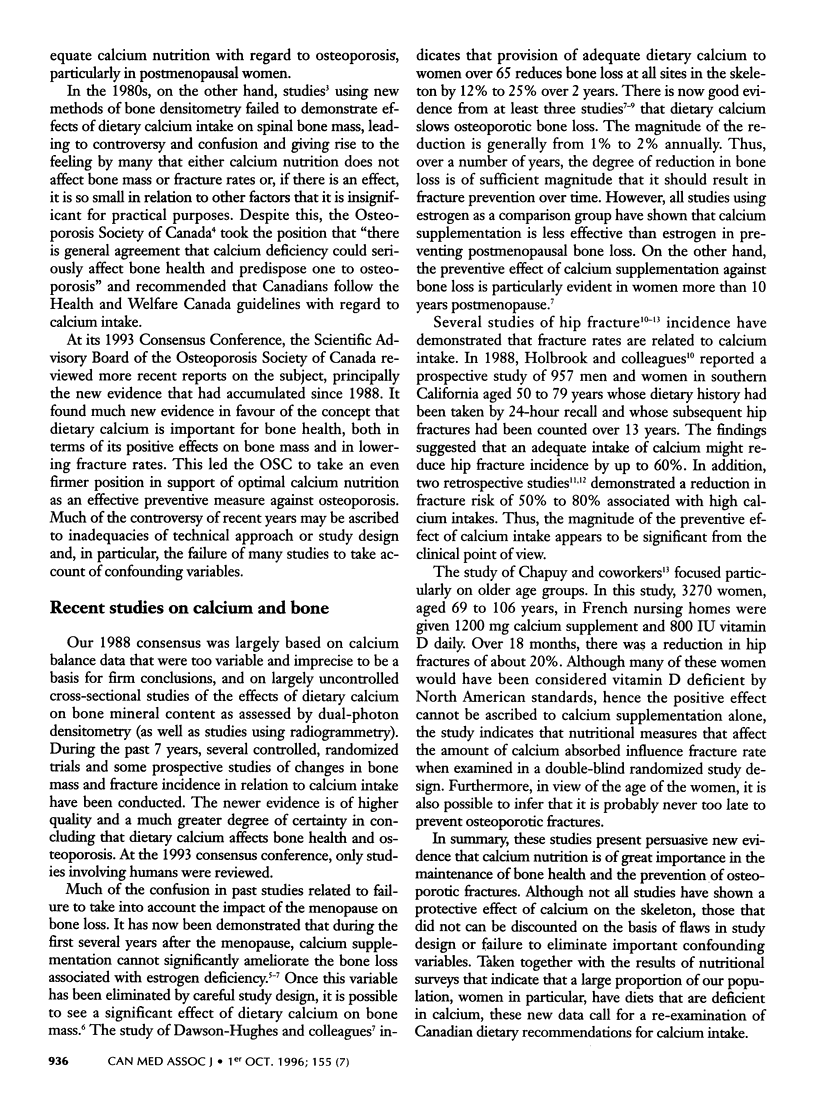
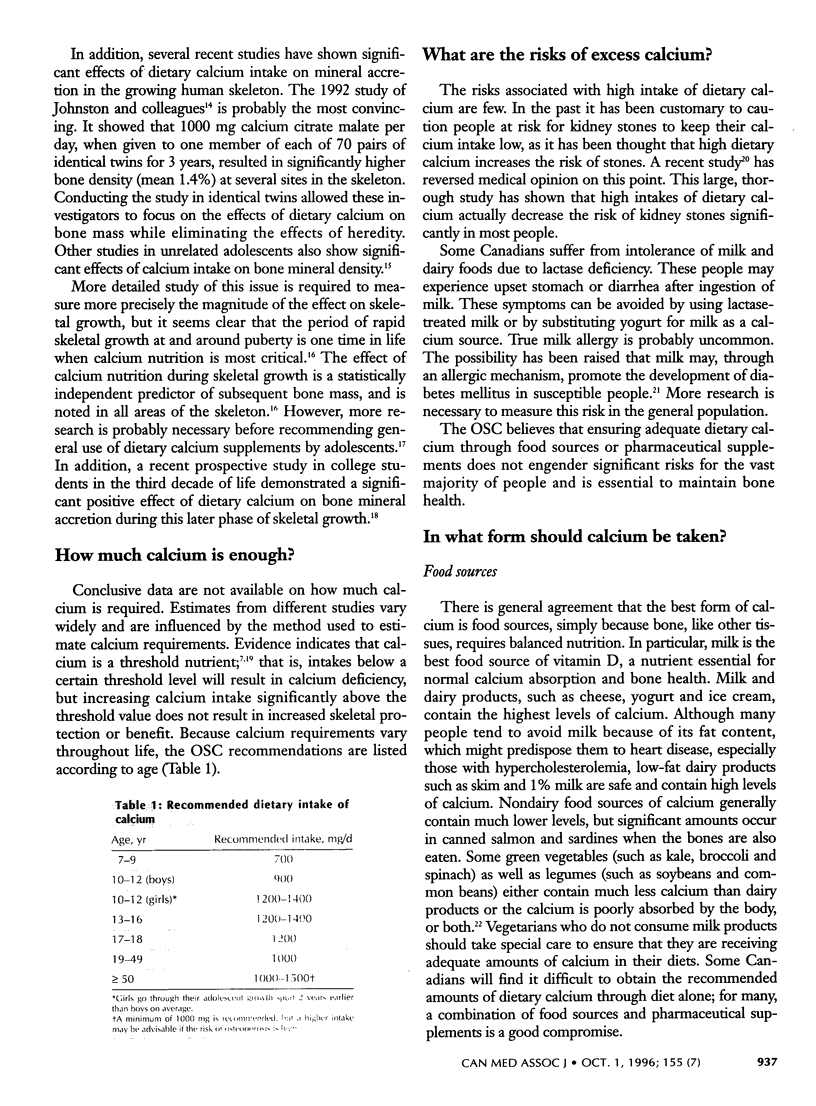
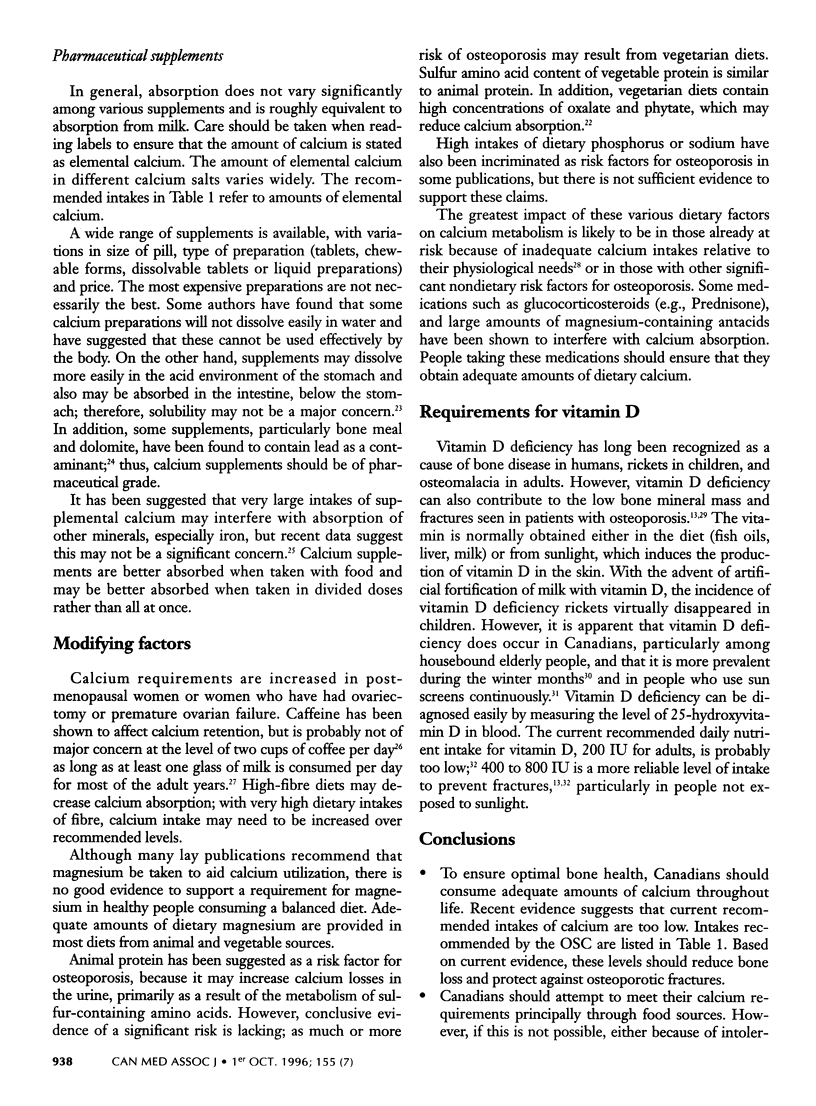
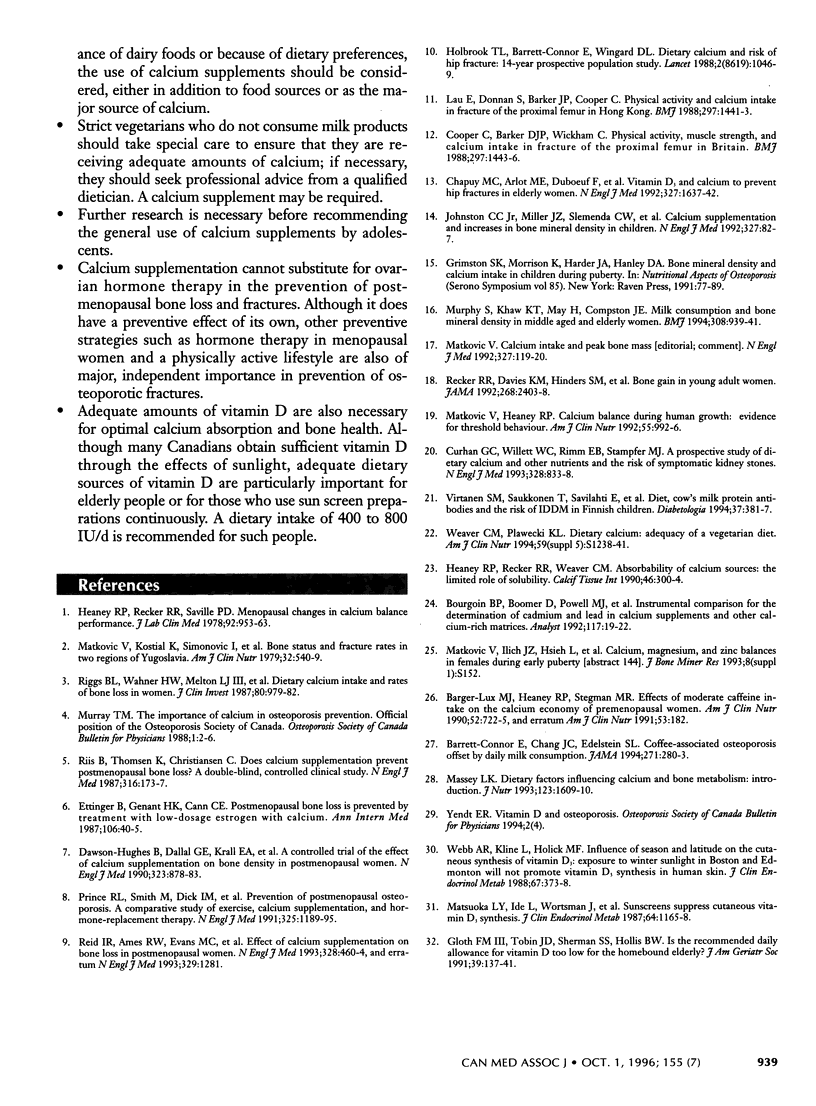
Selected References
These references are in PubMed. This may not be the complete list of references from this article.
- Barger-Lux M. J., Heaney R. P., Stegman M. R. Effects of moderate caffeine intake on the calcium economy of premenopausal women. Am J Clin Nutr. 1990 Oct;52(4):722–725. doi: 10.1093/ajcn/52.4.722. [DOI] [PubMed] [Google Scholar]
- Barrett-Connor E., Chang J. C., Edelstein S. L. Coffee-associated osteoporosis offset by daily milk consumption. The Rancho Bernardo Study. JAMA. 1994 Jan 26;271(4):280–283. doi: 10.1001/jama.1994.03510280042030. [DOI] [PubMed] [Google Scholar]
- Chapuy M. C., Arlot M. E., Duboeuf F., Brun J., Crouzet B., Arnaud S., Delmas P. D., Meunier P. J. Vitamin D3 and calcium to prevent hip fractures in the elderly women. N Engl J Med. 1992 Dec 3;327(23):1637–1642. doi: 10.1056/NEJM199212033272305. [DOI] [PubMed] [Google Scholar]
- Cooper C., Barker D. J., Wickham C. Physical activity, muscle strength, and calcium intake in fracture of the proximal femur in Britain. BMJ. 1988 Dec 3;297(6661):1443–1446. doi: 10.1136/bmj.297.6661.1443. [DOI] [PMC free article] [PubMed] [Google Scholar]
- Curhan G. C., Willett W. C., Rimm E. B., Stampfer M. J. A prospective study of dietary calcium and other nutrients and the risk of symptomatic kidney stones. N Engl J Med. 1993 Mar 25;328(12):833–838. doi: 10.1056/NEJM199303253281203. [DOI] [PubMed] [Google Scholar]
- Dawson-Hughes B., Dallal G. E., Krall E. A., Sadowski L., Sahyoun N., Tannenbaum S. A controlled trial of the effect of calcium supplementation on bone density in postmenopausal women. N Engl J Med. 1990 Sep 27;323(13):878–883. doi: 10.1056/NEJM199009273231305. [DOI] [PubMed] [Google Scholar]
- Ettinger B., Genant H. K., Cann C. E. Postmenopausal bone loss is prevented by treatment with low-dosage estrogen with calcium. Ann Intern Med. 1987 Jan;106(1):40–45. doi: 10.7326/0003-4819-106-1-40. [DOI] [PubMed] [Google Scholar]
- Gloth F. M., 3rd, Tobin J. D., Sherman S. S., Hollis B. W. Is the recommended daily allowance for vitamin D too low for the homebound elderly? J Am Geriatr Soc. 1991 Feb;39(2):137–141. doi: 10.1111/j.1532-5415.1991.tb01615.x. [DOI] [PubMed] [Google Scholar]
- Heaney R. P., Recker R. R., Saville P. D. Menopausal changes in calcium balance performance. J Lab Clin Med. 1978 Dec;92(6):953–963. [PubMed] [Google Scholar]
- Heaney R. P., Recker R. R., Weaver C. M. Absorbability of calcium sources: the limited role of solubility. Calcif Tissue Int. 1990 May;46(5):300–304. doi: 10.1007/BF02563819. [DOI] [PubMed] [Google Scholar]
- Holbrook T. L., Barrett-Connor E., Wingard D. L. Dietary calcium and risk of hip fracture: 14-year prospective population study. Lancet. 1988 Nov 5;2(8619):1046–1049. doi: 10.1016/s0140-6736(88)90065-7. [DOI] [PubMed] [Google Scholar]
- Johnston C. C., Jr, Miller J. Z., Slemenda C. W., Reister T. K., Hui S., Christian J. C., Peacock M. Calcium supplementation and increases in bone mineral density in children. N Engl J Med. 1992 Jul 9;327(2):82–87. doi: 10.1056/NEJM199207093270204. [DOI] [PubMed] [Google Scholar]
- Lau E., Donnan S., Barker D. J., Cooper C. Physical activity and calcium intake in fracture of the proximal femur in Hong Kong. BMJ. 1988 Dec 3;297(6661):1441–1443. doi: 10.1136/bmj.297.6661.1441. [DOI] [PMC free article] [PubMed] [Google Scholar]
- Massey L. K. Dietary factors influencing calcium and bone metabolism: introduction. J Nutr. 1993 Sep;123(9):1609–1610. doi: 10.1093/jn/123.9.1609. [DOI] [PubMed] [Google Scholar]
- Matkovic V. Calcium intake and peak bone mass. N Engl J Med. 1992 Jul 9;327(2):119–120. doi: 10.1056/NEJM199207093270210. [DOI] [PubMed] [Google Scholar]
- Matkovic V., Heaney R. P. Calcium balance during human growth: evidence for threshold behavior. Am J Clin Nutr. 1992 May;55(5):992–996. doi: 10.1093/ajcn/55.5.992. [DOI] [PubMed] [Google Scholar]
- Matković V., Kostial K., Simonović I., Buzina R., Brodarec A., Nordin B. E. Bone status and fracture rates in two regions of Yugoslavia. Am J Clin Nutr. 1979 Mar;32(3):540–549. doi: 10.1093/ajcn/32.3.540. [DOI] [PubMed] [Google Scholar]
- Matsuoka L. Y., Ide L., Wortsman J., MacLaughlin J. A., Holick M. F. Sunscreens suppress cutaneous vitamin D3 synthesis. J Clin Endocrinol Metab. 1987 Jun;64(6):1165–1168. doi: 10.1210/jcem-64-6-1165. [DOI] [PubMed] [Google Scholar]
- Murphy S., Khaw K. T., May H., Compston J. E. Milk consumption and bone mineral density in middle aged and elderly women. BMJ. 1994 Apr 9;308(6934):939–941. doi: 10.1136/bmj.308.6934.939. [DOI] [PMC free article] [PubMed] [Google Scholar]
- Prince R. L., Smith M., Dick I. M., Price R. I., Webb P. G., Henderson N. K., Harris M. M. Prevention of postmenopausal osteoporosis. A comparative study of exercise, calcium supplementation, and hormone-replacement therapy. N Engl J Med. 1991 Oct 24;325(17):1189–1195. doi: 10.1056/NEJM199110243251701. [DOI] [PubMed] [Google Scholar]
- Recker R. R., Davies K. M., Hinders S. M., Heaney R. P., Stegman M. R., Kimmel D. B. Bone gain in young adult women. JAMA. 1992 Nov 4;268(17):2403–2408. [PubMed] [Google Scholar]
- Reid I. R., Ames R. W., Evans M. C., Gamble G. D., Sharpe S. J. Effect of calcium supplementation on bone loss in postmenopausal women. N Engl J Med. 1993 Feb 18;328(7):460–464. doi: 10.1056/NEJM199302183280702. [DOI] [PubMed] [Google Scholar]
- Riggs B. L., Wahner H. W., Melton L. J., 3rd, Richelson L. S., Judd H. L., O'Fallon W. M. Dietary calcium intake and rates of bone loss in women. J Clin Invest. 1987 Oct;80(4):979–982. doi: 10.1172/JCI113191. [DOI] [PMC free article] [PubMed] [Google Scholar]
- Riis B., Thomsen K., Christiansen C. Does calcium supplementation prevent postmenopausal bone loss? A double-blind, controlled clinical study. N Engl J Med. 1987 Jan 22;316(4):173–177. doi: 10.1056/NEJM198701223160401. [DOI] [PubMed] [Google Scholar]
- Virtanen S. M., Saukkonen T., Savilahti E., Ylönen K., Räsänen L., Aro A., Knip M., Tuomilehto J., Akerblom H. K. Diet, cow's milk protein antibodies and the risk of IDDM in Finnish children. Childhood Diabetes in Finland Study Group. Diabetologia. 1994 Apr;37(4):381–387. doi: 10.1007/s001250050121. [DOI] [PubMed] [Google Scholar]
- Webb A. R., Kline L., Holick M. F. Influence of season and latitude on the cutaneous synthesis of vitamin D3: exposure to winter sunlight in Boston and Edmonton will not promote vitamin D3 synthesis in human skin. J Clin Endocrinol Metab. 1988 Aug;67(2):373–378. doi: 10.1210/jcem-67-2-373. [DOI] [PubMed] [Google Scholar]


